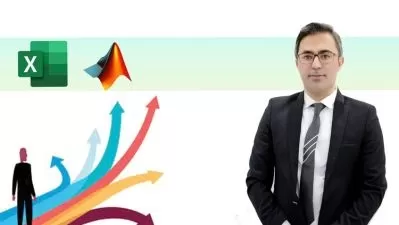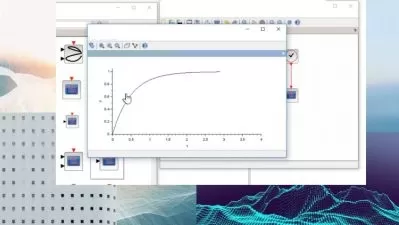Introductory course to DSGE Models in Matlab Dynare
Juan D'Amico
2:18:48
Description
Dive into the world of macroeconomics DSGE models with Matlab Dynare
What You'll Learn?
- How to calibrate a simple DSGE model: The RBC model
- How to estimate a simple DSGE model: The RBC Model
- How to navigate Dynare-Matlab for working with DSGE Models
- How to extend the RBC model by incorporating oil in the production function
Who is this for?
More details
DescriptionAre you looking to dive into the world of macroeconomics DSGE models? Then look no further! This course will serve as your comprehensive guide to utilizing Matlab Dynare for DSGE model analysis. You will gain extensive knowledge and understanding of the fundamental concepts and principles of DSGEs and how they are implemented in Matlab Dynare. Get ready to explore this fascinating field and equip yourself with the skills to solve complex macroeconomic problems!
This course will teach you how to calibrate and estimate DSGE models in Matlab-Dynare. DSGE models are macro-microfounded models which focus on growth and business cycles. As the world of macroeconomics continues to evolve, Dynamic Stochastic General Equilibrium (DSGE) models are becoming increasingly popular. Yet getting familiar with DSGE models and the software Dynare without guidance can be challenging. Unfortunately, there aren't many didactic courses available to help individuals navigate this complex subject and those that do exist come with a hefty price tag (yes, thousands of dollars). It can be discouraging and overwhelming at times, but don't despair! I am here to tell you that help is available, and it doesn't have to cost you an arm and a leg.
I have created this course specifically for individuals seeking guidance on this complex subject.
In this course, I show you step by step how to manually solve a simple RBC model and then how to calibrate it in Dynare. No previous knowledge of the software is required! I will walk you through each part of the process with clear explanations. You'll get to understand the fundamentals of how a model works and gain insight into what goes on behind the scenes when calibrating a model. But that's not all!
Now that we are all familiar with the structure of the basic model, let us explore how we can expand it by introducing oil into the production function. By doing so, we will be able to gain a deeper insight into sources of fluctuation in economies around the world. Adding oil to the model will help us better understand how changes in its availability and price can affect households and firms alike.
We conclude the course by estimating the simple RBC model. I will show you not only how to calibrate a model, but also, the commands you need to know to bring data into the software and estimate it.
If you are new to Dynare and DSGE models, you may feel overwhelmed by all the new information. Never fear though, because I am confident that this course can help you get a handle on it all. This course is tailored for beginners and those who don't have any prior experience with the software, so it should be a great place to start. However, it may not be suitable for advanced MATLAB users.
The course being discussed here is an English-language course, and it allows students to turn on captions in four different languages: English, Spanish, French and Portuguese. This flexibility gives students from all backgrounds access to a learning experience that suits their individual needs and preferences. With these captions available, learners can better follow along with the material and retain what they’ve learned.
Who this course is for:
- The DSGE course is designed to be suitable for a range of users, from students or academics, to financial institutions, corporations or government agencies
- Anyone interested in diving into DSGE models are welcome.
- Ideal for those with little or no experience in Matlab-Dynare as it provides a comprehensive introduction to the language and its relevant applications.
- This course may not be be beneficial for advanced Matlab-Dynare users as it is an introduction to DSGE models and Dynare.
Are you looking to dive into the world of macroeconomics DSGE models? Then look no further! This course will serve as your comprehensive guide to utilizing Matlab Dynare for DSGE model analysis. You will gain extensive knowledge and understanding of the fundamental concepts and principles of DSGEs and how they are implemented in Matlab Dynare. Get ready to explore this fascinating field and equip yourself with the skills to solve complex macroeconomic problems!
This course will teach you how to calibrate and estimate DSGE models in Matlab-Dynare. DSGE models are macro-microfounded models which focus on growth and business cycles. As the world of macroeconomics continues to evolve, Dynamic Stochastic General Equilibrium (DSGE) models are becoming increasingly popular. Yet getting familiar with DSGE models and the software Dynare without guidance can be challenging. Unfortunately, there aren't many didactic courses available to help individuals navigate this complex subject and those that do exist come with a hefty price tag (yes, thousands of dollars). It can be discouraging and overwhelming at times, but don't despair! I am here to tell you that help is available, and it doesn't have to cost you an arm and a leg.
I have created this course specifically for individuals seeking guidance on this complex subject.
In this course, I show you step by step how to manually solve a simple RBC model and then how to calibrate it in Dynare. No previous knowledge of the software is required! I will walk you through each part of the process with clear explanations. You'll get to understand the fundamentals of how a model works and gain insight into what goes on behind the scenes when calibrating a model. But that's not all!
Now that we are all familiar with the structure of the basic model, let us explore how we can expand it by introducing oil into the production function. By doing so, we will be able to gain a deeper insight into sources of fluctuation in economies around the world. Adding oil to the model will help us better understand how changes in its availability and price can affect households and firms alike.
We conclude the course by estimating the simple RBC model. I will show you not only how to calibrate a model, but also, the commands you need to know to bring data into the software and estimate it.
If you are new to Dynare and DSGE models, you may feel overwhelmed by all the new information. Never fear though, because I am confident that this course can help you get a handle on it all. This course is tailored for beginners and those who don't have any prior experience with the software, so it should be a great place to start. However, it may not be suitable for advanced MATLAB users.
The course being discussed here is an English-language course, and it allows students to turn on captions in four different languages: English, Spanish, French and Portuguese. This flexibility gives students from all backgrounds access to a learning experience that suits their individual needs and preferences. With these captions available, learners can better follow along with the material and retain what they’ve learned.
Who this course is for:
- The DSGE course is designed to be suitable for a range of users, from students or academics, to financial institutions, corporations or government agencies
- Anyone interested in diving into DSGE models are welcome.
- Ideal for those with little or no experience in Matlab-Dynare as it provides a comprehensive introduction to the language and its relevant applications.
- This course may not be be beneficial for advanced Matlab-Dynare users as it is an introduction to DSGE models and Dynare.
User Reviews
Rating
Juan D'Amico
Instructor's Courses
Udemy
View courses Udemy- language english
- Training sessions 15
- duration 2:18:48
- English subtitles has
- Release Date 2023/02/13











